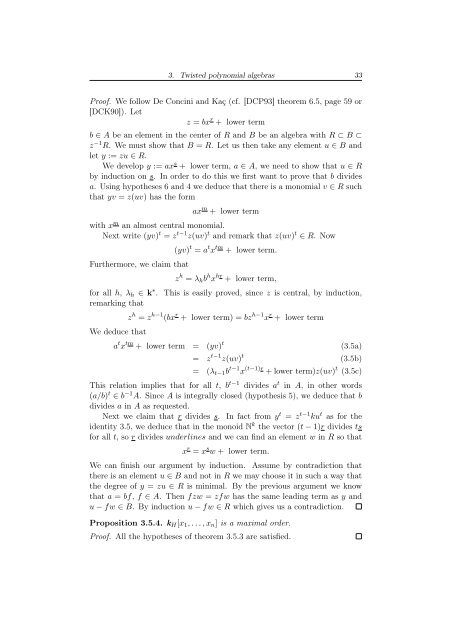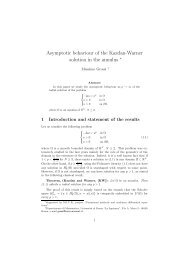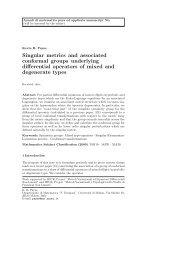Degree of Parabolic Quantum Groups - Dipartimento di Matematica ...
Degree of Parabolic Quantum Groups - Dipartimento di Matematica ...
Degree of Parabolic Quantum Groups - Dipartimento di Matematica ...
Create successful ePaper yourself
Turn your PDF publications into a flip-book with our unique Google optimized e-Paper software.
3. Twisted polynomial algebras 33<br />
Pro<strong>of</strong>. We follow De Concini and Kaç (cf. [DCP93] theorem 6.5, page 59 or<br />
[DCK90]). Let<br />
z = bx r + lower term<br />
b ∈ A be an element in the center <strong>of</strong> R and B be an algebra with R ⊂ B ⊂<br />
z −1 R. We must show that B = R. Let us then take any element u ∈ B and<br />
let y := zu ∈ R.<br />
We develop y := ax s + lower term, a ∈ A, we need to show that u ∈ R<br />
by induction on s. In order to do this we first want to prove that b <strong>di</strong>vides<br />
a. Using hypotheses 6 and 4 we deduce that there is a monomial v ∈ R such<br />
that yv = z(uv) has the form<br />
ax m + lower term<br />
with x m an almost central monomial.<br />
Next write (yv) t = z t−1 z(uv) t and remark that z(uv) t ∈ R. Now<br />
Furthermore, we claim that<br />
(yv) t = a t x tm + lower term.<br />
z h = λhb h x hr + lower term,<br />
for all h, λh ∈ k ∗ . This is easily proved, since z is central, by induction,<br />
remarking that<br />
We deduce that<br />
z h = z h−1 (bx r + lower term) = bz h−1 x r + lower term<br />
a t x tm + lower term = (yv) t<br />
= z t−1 z(uv) t<br />
(3.5a)<br />
(3.5b)<br />
= (λt−1b t−1 x (t−1)r + lower term)z(uv) t (3.5c)<br />
This relation implies that for all t, b t−1 <strong>di</strong>vides a t in A, in other words<br />
(a/b) t ∈ b −1 A. Since A is integrally closed (hypothesis 5), we deduce that b<br />
<strong>di</strong>vides a in A as requested.<br />
Next we claim that r <strong>di</strong>vides s. In fact from y t = z t−1 ku t as for the<br />
identity 3.5, we deduce that in the monoid N k the vector (t − 1)r <strong>di</strong>vides ts<br />
for all t, so r <strong>di</strong>vides underlines and we can find an element w in R so that<br />
x r = x s w + lower term.<br />
We can finish our argument by induction. Assume by contra<strong>di</strong>ction that<br />
there is an element u ∈ B and not in R we may choose it in such a way that<br />
the degree <strong>of</strong> y = zu ∈ R is minimal. By the previous argument we know<br />
that a = bf, f ∈ A. Then fzw = zfw has the same lea<strong>di</strong>ng term as y and<br />
u − fw ∈ B. By induction u − fw ∈ R which gives us a contra<strong>di</strong>ction.<br />
Proposition 3.5.4. kH[x1, . . .,xn] is a maximal order.<br />
Pro<strong>of</strong>. All the hypotheses <strong>of</strong> theorem 3.5.3 are satisfied.








